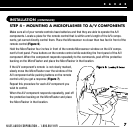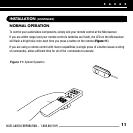
NILES AUDIO CORPORATION – 1-800-BUY-HIFI
15
INSTALLATION (CONTINUED)
PULLING THE CABLE
Whenever you run the cable farther than 4-1/2 feet from a hole in a stud or joist (open attic space,
going up walls, etc.), fasten the cable to the joists or studs using cable clamps or appropriately
sized cable staples. The cable should not have large sags in it, nor should it be too tight. Try to
protect the cable from being stepped on in attics or other unfinished crawl spaces. There are guard
strips, raceways and conduits which can be used to protect the cable. Consult the local building
code for special requirements in your area.
CONCEALING MICROSENSOR CABLE IN EXISTING WALLS
This is actually a fairly simple task if you restrict your choice of the Microsensor location and cable
routes to the interior walls or ceilings of your home. Interior walls in almost all North American
residences are hollow, so that it is easy to route new sensor cable around the house. What you see
when you look at the painted wall board, plaster, or paneling is only the skin of the wall. Behind
the skin is the skeleton; two-by-four wood or metal “studs” running vertically from the floor to the
ceiling in walls and 2 x 6 or larger “joists” running horizontally in the ceilings and floors. In between
the studs and the joists is the space for the wiring and plumbing of your home.
Exterior walls are different. They must insulate the house from the heat and cold outside, so they
are stuffed with insulation. The national building code requires that the hollow wall space in exterior
walls be broken by a horizontal stud placed between the vertical studs. This “fire blocking” makes
it very difficult to retrofit long lengths of cable. In some areas of the country the exterior walls are
constructed of solid masonry, and have no hollow space for cables.


















